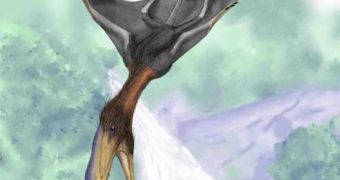The most common depictions of ancient flying reptiles called pterosaurs are simply wrong, a new study demonstrates. In the configuration shown in most books, these bulky animals would have been unable to sustain flying, not even over short distances.
Pterosaurs were giant flying lizards that lived in the Jurassic Period. With wingspans reaching 23 feet (7 meters), the hefty animals were some of the largest ever to take to the skies throughout Earth's long history. The current depictions of pterosaurs have been produced more than 100 years ago.
However, it was only in more recent times that investigators began figuring out the exact physics involved in their flights. These studies began to underline inconsistencies between how the giant reptiles were depicted, and how they must have looked like in reality.
In order for the creatures to fly, their wings should have been shaped like a crescent, and be angled much farther forward from their bodies than previously thought. Additionally, existing estimates of pterosaurs' wing shape and size are also erroneous.
The work was conducted by experts from the University of Bristol (UB) School of Earth Sciences, who were led by research scientist Colin Palmer. Details of the study were published in the September 27 issue of the renowned journal Proceedings of the Royal Society B: Biological Sciences.
“Something as big a pterosaur is really pushing the limits of what's possible. That's what's interesting from an engineering point of view. [This study] does allow us to have a better idea of how things work and throw away a number of things,” he explains.
When in their full adult configuration, pterosaurs were a bit taller than a giraffe while roaming on the ground. They lived more than 200 million years ago, and died with all other dinosaur species during the Cretaceous-Paleogene extinction event, more than 65.5 million years ago.
“To stop it from flapping in flight, you have to have tension in [the wing membrane]. You can only do that by bending the wing bones, like a bow and arrow,” the investigator explains. He adds that new evidence indicate the animals did not need to spend too much time flapping their wings.
Pterosaurs would have spent most of their time gliding on air currents, flapping occasionally in order to correct their course following wind gusts and other similar events. According to the study, they did have to flap their wings in order to be able to land, LiveScience reports.
“When it hits a gust, the wing flexes, the wing bends, in a way to stabilize it. A 7-meter, very flexible wing could actually have flown successfully,” Palmer concludes.

 14 DAY TRIAL //
14 DAY TRIAL //